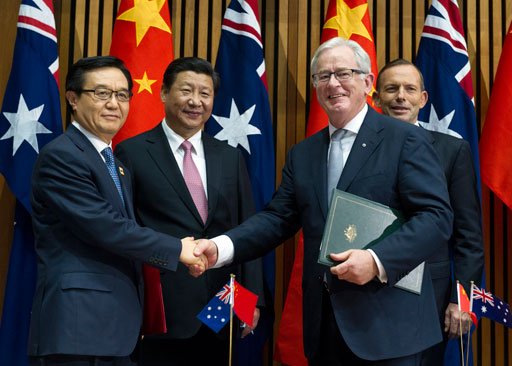Free Trade Agreements – economic or electoral?

Since September 2013, the ‘achievements’ of our government could be broadly summarised by ‘knock it down, rip it up, sell it off or shoot it.’
Their one supposedly constructive achievement, apart from promises about roads, is hastily finalising several free trade agreements.
Aside from the co-incidence/concern of agreements that had been negotiated over several years all reaching conclusion at the same time (what did we agree to?), are these actually in Australia’s best interests or are they just political opportunities?
When John Howard signed the Free Trade Agreement with the US in 2004, it was suggested that his motive was electoral rather than economic – to highlight the American alliance and hope that if Labor opposed it it could be cast as anti-American, and hence a security risk.
The Coalition’s reaction to Labor’s attempts to safeguard Australian jobs in the China FTA has used a similar approach, branding Labor as racist.
In the first five years after the signing of the US FTA, Australia’s exports to the US grew by only 2.5 per cent, compared with double-digit growth for exports to all the major Asian trading partners. America slipped from third to fifth among Australian export destinations, overtaken by Korea and India.
By 2009, the value of Australian exports to the US was only about a quarter of those to the two leading customers, China and Japan. The four Asian countries together took more than 10 times the value of exports to the US despite having no such trade agreements.
Moreover, between 2004 and 2009, the bilateral trade gap in America’s favour grew even larger. Australia’s imports from America grew much more quickly than its exports to America. According to US data, the gap in America’s favour grew from $US6.4 billion to $US11.6 billion.
In 2004 Australian exports to America were worth about 54 per cent of the value of imports from that country. By 2009 the figure was down to 41 per cent.
And our current endeavours do not promise any better.
Hockey’s second MYEFO showed a revenue write-down of $1.6 billion due to the FTA with Japan.
Also, the agreements with Japan and Korea effectively sounded the death knell for our car industry and manufacturing more broadly.
The Chinese deal on beef is only for an extra 10% exports before a trigger where tariffs will be charged again, and the proposed tariff reduction will not fully take place for nine years.
Agribusiness lawyer Lea Fua told a Brisbane hearing that China has a safeguard clause which allows it to add customs duties to fresh and frozen beef carcasses and meat when Australian beef imports hit a volume trigger of 170,000 tonnes.
“In 2013-14, Australia exported 161,000 tonnes of beef to China worth $787 million,” Mr Fua told the Joint Parliamentary Committee on Treaties.
“The concern here is that given the growth in Australian beef exports to China, which has been exponential in the last few years, the risk here is that the trigger will be reached fairly quickly and China is able to apply extra customs duty which appears to be against the spirit of chapter two [of the FTA],” he said.
Mr Fua said a similar situation applies to Chinese imports of Australian milk and cream solids.
As Bob Katter has warned, rather than being the food bowl for Asia, on current trajectory, Australia will become a net importer of food, and pretty much everything else other than coal and iron ore. This will have significant implications for domestic prices as farmers can make a greater profit by exporting their produce.
If, as the unions warn, foreign companies are allowed to bring in their own workers, it becomes even more difficult to believe these agreements are in the best interests of our country.
A bilateral meeting with a friendly leader presents many domestic political advantages. It gives the appearance of advancing the national interests and attracts intense and usually uncritical media coverage, but it inevitably favours the biggest countries, such as the US and China. Their power affords them superior bargaining leverage to win concessions favouring their domestic constituencies.
After bilateral meetings, leaders can sing each other’s praises and hail the breakthrough their mutual brilliance has achieved. In practice, the promised benefits often fade just a little more slowly than the TV lights.









